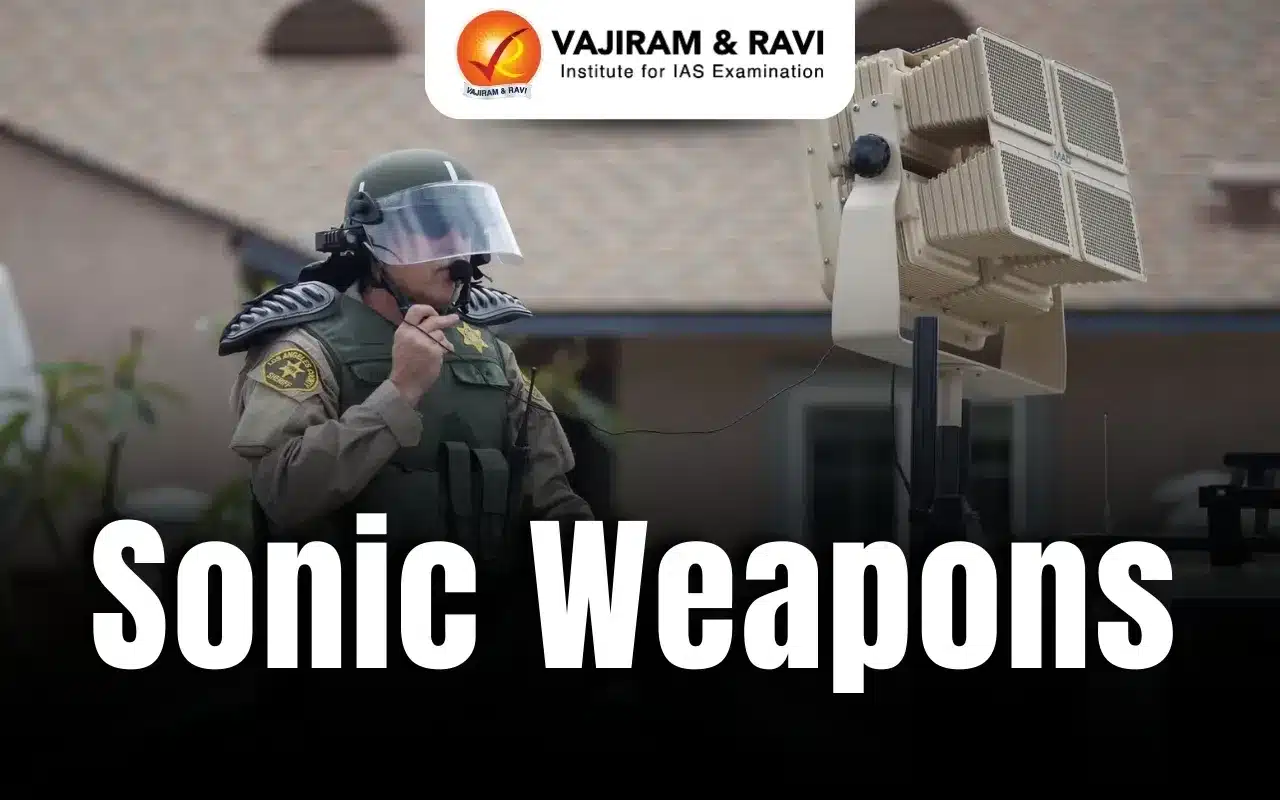Sonic Weapons Latest News
Serbia’s government has been accused of using a banned ‘sonic weapon’ to disperse protesters in Belgrade.
What are Sonic Weapons?
- Sonic weapons (Acoustic Weapons) are devices that deliver loud, painful sounds over long distances.
- They can emit audible or inaudible sound waves to disrupt, disorient, or incapacitate people.
- Some versions act as voice amplifiers, allowing authorities to issue commands over large distances.
- First developed for military and crowd control purposes, they were used in Iraq (2004) by the U.S. military.
How Do Sonic Weapons Work?
- They use hundreds of transducers (electronic devices that convert energy into sound waves).
- The highly concentrated and amplified sound can be directed at specific targets.
- Authorities control the frequency, volume, and duration of the sound.
- The narrow sound beam can cause extreme discomfort, pain, and disorientation to those exposed.
Types of Sonic Weapons
- Long-Range Acoustic Device (LRAD): Used by law enforcement and military for crowd control. Can project sound over 8,900 meters at up to 160 decibels (dB).
- Causes ear pain, hearing damage, nausea, and dizziness.
- Mosquito Device: Emits a high-pitched sound that only younger people (below 30 years) can hear. Used to deter loitering in public areas.
- Causes irritation and discomfort in young individuals.
- Infrasonic Weapon: Emits low-frequency sounds that are inaudible to humans but cause physical pain and disorientation. Still under research.
- Potential to cause headaches, nausea, vertigo, and internal organ damage.
Sonic Weapons FAQs
Q1. What are sonic weapons?
Ans. Sonic weapons, also known as acoustic weapons, use sound waves to cause discomfort, disorientation, pain, or damage to targets. They can be used for crowd control, military defense, or non-lethal deterrence.
Q2. How do sonic weapons work?
Ans. Sonic weapons emit high-intensity sound waves, either in audible or infrasonic/ultrasonic ranges. These waves can affect human balance, cause nausea, disorient enemies, or even damage eardrums and internal organs.
Q3. Are sonic weapons lethal?
Ans. Most sonic weapons are designed as non-lethal tools for deterrence. However, at extreme intensities and prolonged exposure, they can cause serious harm, including permanent hearing loss or internal injuries.
Q4. Who uses sonic weapons?
Ans. Sonic weapons are used by military forces, law enforcement agencies, and security personnel. Countries like the U.S., China, and Russia have developed or deployed them for riot control, area denial, and crowd management.
Source: IE
Last updated on December, 2025
→ Check out the latest UPSC Syllabus 2026 here.
→ Join Vajiram & Ravi’s Interview Guidance Programme for expert help to crack your final UPSC stage.
→ UPSC Mains Result 2025 is now out.
→ UPSC Notification 2026 is scheduled to be released on January 14, 2026.
→ UPSC Calendar 2026 is released on 15th May, 2025.
→ The UPSC Vacancy 2025 were released 1129, out of which 979 were for UPSC CSE and remaining 150 are for UPSC IFoS.
→ UPSC Prelims 2026 will be conducted on 24th May, 2026 & UPSC Mains 2026 will be conducted on 21st August 2026.
→ The UPSC Selection Process is of 3 stages-Prelims, Mains and Interview.
→ UPSC Result 2024 is released with latest UPSC Marksheet 2024. Check Now!
→ UPSC Prelims Result 2025 is out now for the CSE held on 25 May 2025.
→ UPSC Toppers List 2024 is released now. Shakti Dubey is UPSC AIR 1 2024 Topper.
→ UPSC Prelims Question Paper 2025 and Unofficial Prelims Answer Key 2025 are available now.
→ UPSC Mains Question Paper 2025 is out for Essay, GS 1, 2, 3 & GS 4.
→ UPSC Mains Indian Language Question Paper 2025 is now out.
→ UPSC Mains Optional Question Paper 2025 is now out.
→ Also check Best IAS Coaching in Delhi

















